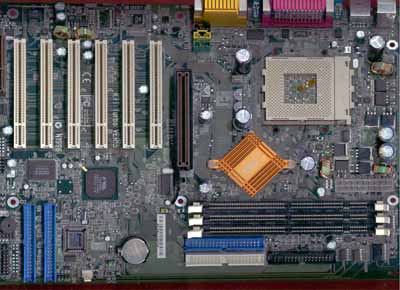MSI K7T Turbo Socket-A KT133A ATX
by Mike Andrawes on January 30, 2001 1:49 AM EST- Posted in
- Motherboards
Spotting our old Friend
Once again, we see the trend of motherboard manufacturers using the same KT133 motherboard layout for their KT133A solution. The K7T Turbo measures in at 12 by 9 inches, slightly larger than the K7T Pro2. The layout design is based largely on the K7T Pro2, but with more modifications than most manufacturers are making.
The biggest and most obvious of these changes is the addition of a Promise IDE RAID controller, which accounts for the increased size of the PCB.
MSI and ABIT are the only two manufacturers to have the VIA 8363A North Bridge rotated by 45 degrees. They claim that such a layout results in shorter traces and thus cleaner signals, which is probably one of the reasons why the board is extremely stable under our stress tests.
However, unlike the ABIT KT7A-RAID and the EPoX EP-8KTA3, MSI did not put a fan on the 8363A North Bridge, going with just a standard heatsink instead, just like the old K7T Pro2. As we have shown before, even though the 8363 North Bridge of the KT133 chipset does not necessarily need any special cooling, that is not the case with the 8363A North Bridge, especially when it comes to overclocked FSB speeds. A bit later, we’ll take a look and see if the stand alone heat sink is sufficient.

Is this heat sink enough to cool the hot KT133A North Bridge?
CPU cooling has been one of the most important factors when dealing with the high-speed processors we have today. With CPUs in the gigahertz range dissipating more than 50W of heat, a cooling failure could result in a highly unstable system. Fortunately, MSI has prepared carefully for such circumstances.
First, they left a lot of space around the CPU socket, so you should not have any problems in installing even the largest HSF unit. The power supply connector is located right beside the DIMM slots, so the ATX power cable will not interfere with airflow to the CPU.
The primary/secondary IDE connectors and the floppy connectors are located right in front of the DIMM slots, however the two IDE connectors by the Promise RAID controller are placed in-line with the fifth and sixth PCI slots, so you will not be able to put in any long PCI devices in those slots.











0 Comments
View All Comments